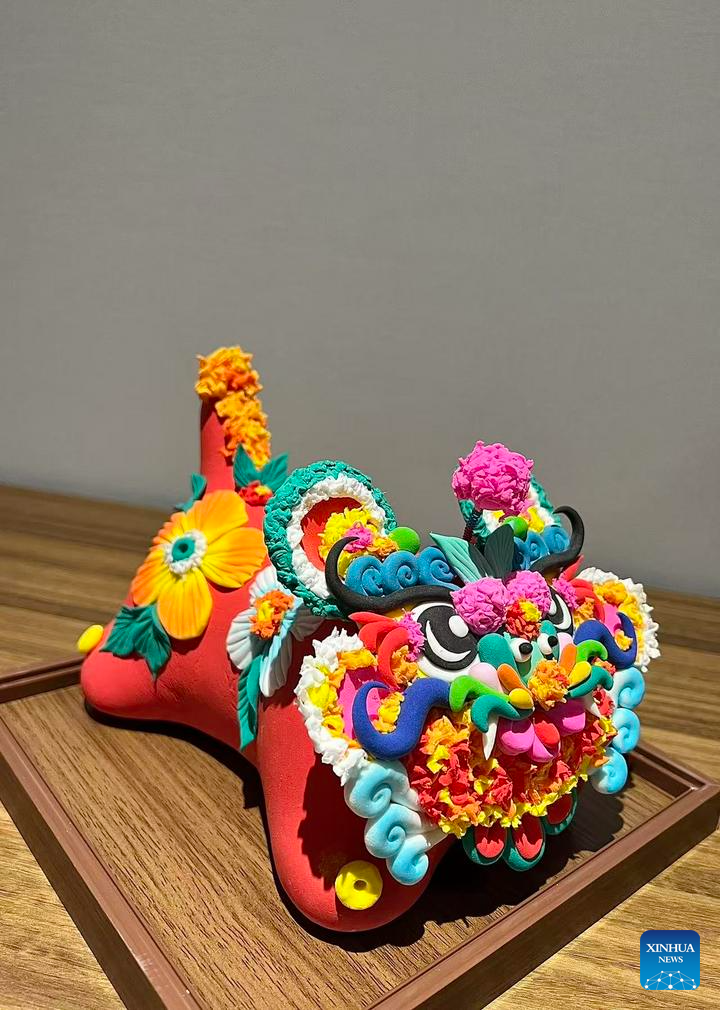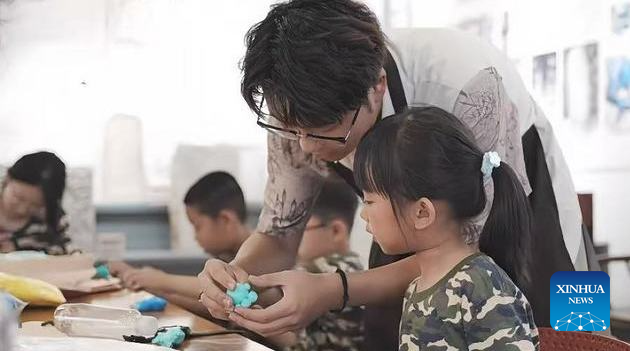


This photo taken on Oct. 6, 2025 shows Zhou Tiancong's dough figurine work of a tiger in Yantai, east China's Shandong Province. (Xinhua)
JINAN, Oct. 11 (Xinhua) -- When 22-year-old Zhou Tiancong from Yantai in east China's Shandong Province returned to his college after the recent eight-day National Day and Mid-Autumn Festival holiday, his luggage stood out: a bag of flour and several freshly made, cartoon-style fruit-shaped Huabobo -- steamed buns representing Chinese folk dough art.
Back at the college's intangible cultural heritage research center, Zhou's fellow students were eagerly waiting to exchange ideas with him about their own holiday creations.
A centuries-old craft recognized as a provincial intangible cultural heritage in Shandong, Jiaodong Huabobo is far more than just steamed buns. Significantly larger than ordinary ones, they are skillfully molded by artisans into symbolic forms like mandarin ducks, carp, dragons, phoenixes and longevity peaches, all carrying auspicious messages in Chinese culinary tradition.
After steaming and cooling, they are painted in vibrant colors, transformed into vivid artworks that symbolize prosperity and a thriving life. They play a central role in Chinese folk customs for weddings, birthdays and festivals.
Now, this traditional art is gaining fresh momentum from China's post-2000s generation. In the hands of Zhou, Huabobo has been reinvented with modern twists and creative concepts.
His latest design, celebrating both the National Day and the Mid-Autumn Festival, features a two-tiered "cake" adorned with exaggerated cartoon figures of the Lunar Goddess Chang'e and her pet -- Yutu (jade rabbit) -- in Chinese mythology.
Zhou's fascination with Huabobo began in childhood. He would linger at festive banquets, captivated by the intricate dough sculptures, reluctant to look away. His passion was ignited during a primary school session on intangible cultural heritage, where he first tried making Huabobo himself -- an experience that sparked a lasting devotion.
China joined the UNESCO Convention for the Safeguarding of the Intangible Cultural Heritage in 2004. To date, the country leads the world with 44 items inscribed on UNESCO's intangible cultural heritage lists.
In recent years, China has been actively building systems to nurture intangible cultural heritage talent, promoting heritage workshops and integrating traditional mentorship with modern education. This has attracted growing numbers of post-2000s youth, who are breathing new life into traditional crafts through creative innovation.
At the intangible cultural heritage research center of Taishan College of Science and Technology, Zhou and his fellow students experiment weekly in their "Huabobo Lab," a dough modeling workshop he established with the college's support, where he regularly guides students alongside instructors.
"Making Huabobo is a nuanced art," Zhou said. "Seemingly minor variables -- the batch of flour, water hardness, temperature, humidity -- can spark completely different artistic outcomes."
"Huabobo is a centuries-old treasure, and I want to create innovative works that express the vitality of youth," Zhou said. His dough creations, along with those of his peers, range from traditional figures like ancient court ladies and opera roles to popular animation characters and his own original cartoons. He aspires to build his own brand and develop a unique cultural IP.
In August, Zhou took his first entrepreneurial step by opening a Huabobo store in his hometown, which quickly became a hit. During holidays, he would sometimes work from 7 a.m. until after 2 a.m. the next morning. "It's tiring, but deeply satisfying," he said. The creative process brings him a sense of fulfillment and inner peace.
Looking ahead, he plans to launch Huabobo DIY kits, aiming to make them not only visually appealing and tasty but also a medium for emotional connection. Through these efforts, he hopes to transform this tradition from festive food into a cultural symbol embraced by the younger generation. ■

Zhou Tiancong guides a girl to make Huabobo in Yantai, east China's Shandong Province, Sept. 12, 2025. (Xinhua)
点击右上角![]() 微信好友
微信好友
 朋友圈
朋友圈

请使用浏览器分享功能进行分享
